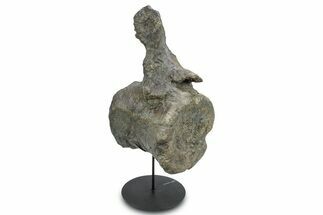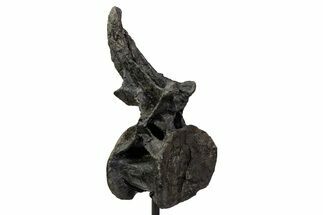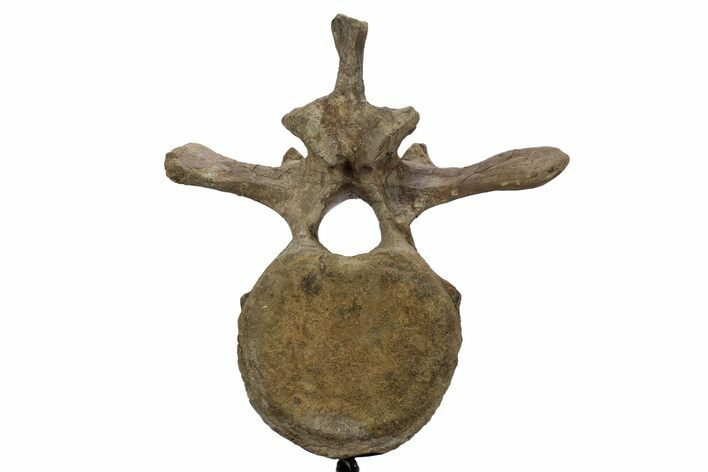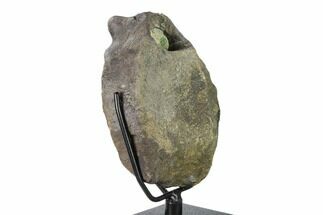This Specimen has been sold.
13.1" Triceratops Caudal Vertebra on Metal Stand - Wyoming
This is a beastly caudal (tail) vertebra of Triceratops horridus, collected from the Lance (Creek) Formation of Wyoming. It is in excellent condition, complete with transverse processes, spinous process, prezygapophyses/postzygapophyses, and an intact neural canal that has had the rock removed. The preservation of the processes is amazing considering these features are fairly fragile and can become detached and lost over the years. It comes with a custom metal display stand for aesthetic vertical presentation of this incredible vertebra.
This vertebra measures 13.1" tall by 12.5" wide, with a 3.9" thick centrum. On the stand, the entire specimen stands 16" tall.
There is some repair and restoration to each transverse process, with the most restoration through the right process. There are repaired cracks through each pedicle with spots of gap fill restoration where the bone crumbled away. Both prezygapophyses and postzygapophyses are intact with spots of gap fill restoration and/or crack repair. There is some minor breakage at the superior end of the spinous process, with a couple repaired cracks through the middle. Restoration only makes up approximately 5% of the entire specimen which is quite incredible.
This vertebra measures 13.1" tall by 12.5" wide, with a 3.9" thick centrum. On the stand, the entire specimen stands 16" tall.
There is some repair and restoration to each transverse process, with the most restoration through the right process. There are repaired cracks through each pedicle with spots of gap fill restoration where the bone crumbled away. Both prezygapophyses and postzygapophyses are intact with spots of gap fill restoration and/or crack repair. There is some minor breakage at the superior end of the spinous process, with a couple repaired cracks through the middle. Restoration only makes up approximately 5% of the entire specimen which is quite incredible.
About Triceratops
Triceratops is one of the most recognized and intriguing of the North American ceratopsid dinosaurs. They stomped around the Late Cretaceous (around 68-66 mya), brandishing their three-pronged and bony frilled skulls, chewing on fibrous plants. They struggled against large predators, stood their ground, and tried not to be devoured by the ferocious Tyrannosaurus rex.
The head on a Triceratops may have been an intimidating show rather than a stabbing, defensive trident and imposing shield for inter-species jousting. Researchers have given close scrutiny to the holes, or fenestrae, of other ceratopsid crests. In the past, the holes within the shield were used to confirm separate species.
Individual Triceratops are estimated to have reached up to 9 meters (29.5 feet) in length, 3 meters (9.8 feet) in height, and weighed up to 26,000 pounds. The largest known skull is estimated to have been 2.5 meters (8.2 feet) long and would have extended almost a third of the length of the mature individual. The pointed horns were approximately 1 meter (3 feet) long. With its sturdy build and powerful legs, Triceratops could have ripped open the predator that wanted this herbivore for dinner.
One of the most abundant of the large Cretaceous fauna, Triceratops plucked low growth with its beak-tipped jaws. Triceratops teeth were arranged in groups, called batteries, of 36 to 40 tooth columns, in each side of each jaw. Each column contained about 3 to 5 stacked teeth, depending on the individual’s size. This produced a range of 432 to 800 teeth, of which only a fraction were in use at any given time (due to tooth replacement). The great size and quantity of teeth suggests that they ate large volumes of fibrous plants. These were possibly palms, cycads, and ferns.
Triceratops was designated as the state fossil of South Dakota in 1988.
Triceratops is one of the most recognized and intriguing of the North American ceratopsid dinosaurs. They stomped around the Late Cretaceous (around 68-66 mya), brandishing their three-pronged and bony frilled skulls, chewing on fibrous plants. They struggled against large predators, stood their ground, and tried not to be devoured by the ferocious Tyrannosaurus rex.
The head on a Triceratops may have been an intimidating show rather than a stabbing, defensive trident and imposing shield for inter-species jousting. Researchers have given close scrutiny to the holes, or fenestrae, of other ceratopsid crests. In the past, the holes within the shield were used to confirm separate species.
Individual Triceratops are estimated to have reached up to 9 meters (29.5 feet) in length, 3 meters (9.8 feet) in height, and weighed up to 26,000 pounds. The largest known skull is estimated to have been 2.5 meters (8.2 feet) long and would have extended almost a third of the length of the mature individual. The pointed horns were approximately 1 meter (3 feet) long. With its sturdy build and powerful legs, Triceratops could have ripped open the predator that wanted this herbivore for dinner.
One of the most abundant of the large Cretaceous fauna, Triceratops plucked low growth with its beak-tipped jaws. Triceratops teeth were arranged in groups, called batteries, of 36 to 40 tooth columns, in each side of each jaw. Each column contained about 3 to 5 stacked teeth, depending on the individual’s size. This produced a range of 432 to 800 teeth, of which only a fraction were in use at any given time (due to tooth replacement). The great size and quantity of teeth suggests that they ate large volumes of fibrous plants. These were possibly palms, cycads, and ferns.
Triceratops was designated as the state fossil of South Dakota in 1988.
About The Lance Formation
The Lance Formation of eastern Wyoming is a Late Cretaceous (69–66 million years old) unit that represents the same geologic age as the famous Hell Creek Formation of Montana and the Dakotas. Although they are time-equivalent, the Lance and Hell Creek preserve subtly different environments. Hell Creek reflects a humid, forested coastal plain punctuated by volcanic ash deposits, while the Lance records a slightly drier, more open floodplain landscape with broader river systems and fewer ash layers. Together, they provide a complementary view of life in the final chapter of the dinosaur era.
Perhaps the most famous Lance resident would be Tyrannosaurus rex, the largest North American carnivore to ever live. However, other smaller theropods also roamed the American midwest in this subtropical coastal stream system, including the beaked Ornithomimus, a lanky running theropod with a build similar to a modern ostrich, as well as several small predatory troodonts such as Paronychodon and Pectinodon.
Herbivorous dinosaurs also took advantage of the abundance offered by this unique era. Armored ankylosaurs dwelt in herds, their safety assured by their numbers, their heavy bone plating protecting most of their bodies and even their eyelids, and huge bone clubs on the ends of their tails providing them with powerful offensive capabilities. Ceratopsians like the famous Triceratops also formed protective herds, guarding their necks with frills and horns. Their smaller relatives, the dome-headed pachycephalosaurs, were also well represented in the area. Hadrosaurs, duck-billed titans with huge batteries of plant-grinding teeth in elongated snouts, are also well known from the region.
In addition to dinosaurs, a wide variety of fishes, amphibians, lizards, snakes, turtles, champsosaurs, crocodilians, and pterosaurs have been found in the formation.
The Lance Formation of eastern Wyoming is a Late Cretaceous (69–66 million years old) unit that represents the same geologic age as the famous Hell Creek Formation of Montana and the Dakotas. Although they are time-equivalent, the Lance and Hell Creek preserve subtly different environments. Hell Creek reflects a humid, forested coastal plain punctuated by volcanic ash deposits, while the Lance records a slightly drier, more open floodplain landscape with broader river systems and fewer ash layers. Together, they provide a complementary view of life in the final chapter of the dinosaur era.
Perhaps the most famous Lance resident would be Tyrannosaurus rex, the largest North American carnivore to ever live. However, other smaller theropods also roamed the American midwest in this subtropical coastal stream system, including the beaked Ornithomimus, a lanky running theropod with a build similar to a modern ostrich, as well as several small predatory troodonts such as Paronychodon and Pectinodon.
Herbivorous dinosaurs also took advantage of the abundance offered by this unique era. Armored ankylosaurs dwelt in herds, their safety assured by their numbers, their heavy bone plating protecting most of their bodies and even their eyelids, and huge bone clubs on the ends of their tails providing them with powerful offensive capabilities. Ceratopsians like the famous Triceratops also formed protective herds, guarding their necks with frills and horns. Their smaller relatives, the dome-headed pachycephalosaurs, were also well represented in the area. Hadrosaurs, duck-billed titans with huge batteries of plant-grinding teeth in elongated snouts, are also well known from the region.
In addition to dinosaurs, a wide variety of fishes, amphibians, lizards, snakes, turtles, champsosaurs, crocodilians, and pterosaurs have been found in the formation.
SPECIES
Triceratops horridus
LOCATION
Wyoming
FORMATION
Lance Formation
SIZE
13.1 x 12.5", 16" tall on stand
CATEGORY
SUB CATEGORY
ITEM
#242359
We guarantee the authenticity of all of our specimens.
 Reviews
Reviews



















